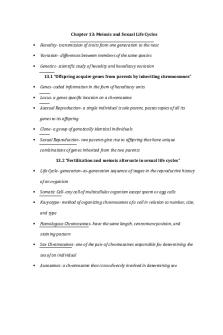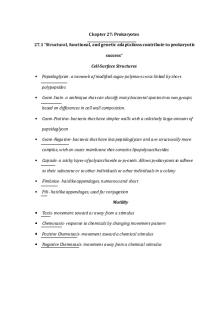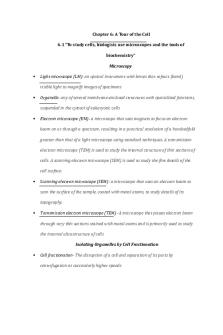Chapter 3 Vocab - Summary Campbell Biology PDF

| Title | Chapter 3 Vocab - Summary Campbell Biology |
|---|---|
| Course | Introduction to Biology A |
| Institution | University of Pennsylvania |
| Pages | 4 |
| File Size | 81.7 KB |
| File Type | |
| Total Downloads | 44 |
| Total Views | 129 |
Summary
Vocab definitions...
Description
Chapter 3- Water and the Fitness of the Environment 3.1 “The polarity of water molecules results in hydrogen bonding”
Polar Molecule- The two ends of the molecule have opposite charges. Electrons spend more time near oxygen than hydrogen because it is more electronegative. 3.2 “Four emergent properties of water contribute to Earth’s fitness for life”
Cohesion- The way that hydrogen bonds hold water together, even though the arrangement of molecules in water is constantly changing. Contributes to the transport of water and dissolved nutrients against gravity in plants.
Adhesion- Sticking. Water to cell walls by hydrogen bonds helps counter the downward pull of gravity.
Kinetic Energy- The energy of motion. Atoms have this because they are always moving. Faster = Greater
Heat- A form of energy. Measure of the matter's total kinetic energy due to motion of its molecules.
Temperature- Measure of heat intensity. Represents the average kinetic energy of the molecules, regardless of volume.
Celsius Scale- Indicates temperature. Water freezes at 0ºC and boils at 100ºC. Human body averages 37ºC and room temp. is 20-25ºC.
Calorie- Unit of heat. Amount of heat it takes to raise the temperature of 1g of water 1ºC
Kilocalorie- Quantity of heat required to raise the temperature of 1kg of water 1ºC. The calories on food packages.
Joule- Energy unit. 0.239 cal. 1 cal =4.184 J
Specific Heat- The amount of heat absorbed of lost for 1g of that substance to change its temperature 1ºC. A measure of how well a substance resists changing its temperature when it absorbs or releases heat. Water's is 1cal/g/ºC, which is unusually high- caused by hydrogen bonds.
Evaporation- Transformation from liquid to gas. Occurs when molecules are moving fast enough to overcome attractions and enter the air as a gas.
Heat of Vaporization- Quantity of heat a liquid must absorb for 1g of it to be converted from the liquid to the gaseous state. Water's is high- an emergent property caused by hydrogen bonds. (580 cal to evaporate 1g at 25ºC)
Evaporative Cooling- As a liquid evaporates, the surface that remains cools down. The hottest molecules with the greatest kinetic energy are most likely to leave as a gas.
Water- Expands when it solidifies. Is less dense as a solid than a liquid due to hydrogen bonding. Becomes locked into a crystalline lattice with each water molecule hydrogen bonded to four partners, and hydrogen bonds keep the molecules at "arm's length."
Solution- A liquid that is a completely homogeneous mixture of two or more substances.
Solvent- The dissolving agent of a solution.
Solute- The substance that is dissolved.
Aqueous Solution - A solution in which water is the solvent.
Hydration Shell- The sphere of water molecules around each dissolved ion.
Hydrophilic- Substance with an affinity for water.
Colloid- A stable suspension of fine particles in a liquid. (Some substances can be hydrophilic without dissolving and are so large that the do not dissolve, and they remain suspended in the aqueous liquid. Ex: Cotton)
Hydrophobic- Substances that do not have an affinity for water. Nonionic and nonpolar substances. (Ex: vegetable oil)
Molecular Mass- Sum of the masses of all the atoms in a molecule. (Ex: Sucrose- 342 daltons)
Mole- An exact number of objects- 6.0210^23 (Avogadro's number). 6.0210^23 daltons in 1g. (342 represents 6.02*10^23 molecules of sucrose or 1 mol of sucrose). Mole of one substance has the exact same number of molecules as the mole of any other substance.
Molarity- The number of moles of solute per liter of solution. (342 g of sucrose and add water until it reaches 1L= 1 M or 1-Molar solution. 3.3 “Dissociation of water molecules leads to acidic and basic conditions that affect living organisms”
Hydrogen Ion- H+. A single proton with a charge of 1+. Occurs when a hydrogen atom participating in a hydrogen bond shifts from one molecule to the other, but leaves an electron behind. Does not exist on its own in an aqueous solution (always associated with water in the form of H3O+).
Hydroxide Ion- (OH-) A water molecule that lost a protein, which has a charge of 1-.
Hydronium Ion- (H3O+) when the proton binds to the other water molecule.
Acid- A substance that increases the hydrogen ion concentration of a solution. An acidic solution has more H+ than OH-. pH 0-6
Base- A substance that reduces the hydrogen ion concentration of a solution. Directly accept the hydrogen ions. Solutions with a higher concentration of OHthan H+. pH 8-14
Neutral- A solution with equal concentration H+ and OH-. pH 7
pH- Defined as the negative logarithm (base 10) of the hydrogen ion concentration. Based on H+ concentration but implies OH- Concentration.
Buffers- Substances that minimize changes of H+ and OH- concentrations in a solution. Accept hydrogen ions when they are in excess and donate when the have been depleted. Most contain a weak acid and its corresponding base. (Ex: Carbonic acid in blood)
Acid Precipitation- Rain, snow, or fog with a pH lower than pH 5.2 (uncontaminated rain is 5.6). Electric power plants produce these oxides. Can damage life in lakes or streams and affect soil....
Similar Free PDFs
Popular Institutions
- Tinajero National High School - Annex
- Politeknik Caltex Riau
- Yokohama City University
- SGT University
- University of Al-Qadisiyah
- Divine Word College of Vigan
- Techniek College Rotterdam
- Universidade de Santiago
- Universiti Teknologi MARA Cawangan Johor Kampus Pasir Gudang
- Poltekkes Kemenkes Yogyakarta
- Baguio City National High School
- Colegio san marcos
- preparatoria uno
- Centro de Bachillerato Tecnológico Industrial y de Servicios No. 107
- Dalian Maritime University
- Quang Trung Secondary School
- Colegio Tecnológico en Informática
- Corporación Regional de Educación Superior
- Grupo CEDVA
- Dar Al Uloom University
- Centro de Estudios Preuniversitarios de la Universidad Nacional de Ingeniería
- 上智大学
- Aakash International School, Nuna Majara
- San Felipe Neri Catholic School
- Kang Chiao International School - New Taipei City
- Misamis Occidental National High School
- Institución Educativa Escuela Normal Juan Ladrilleros
- Kolehiyo ng Pantukan
- Batanes State College
- Instituto Continental
- Sekolah Menengah Kejuruan Kesehatan Kaltara (Tarakan)
- Colegio de La Inmaculada Concepcion - Cebu















